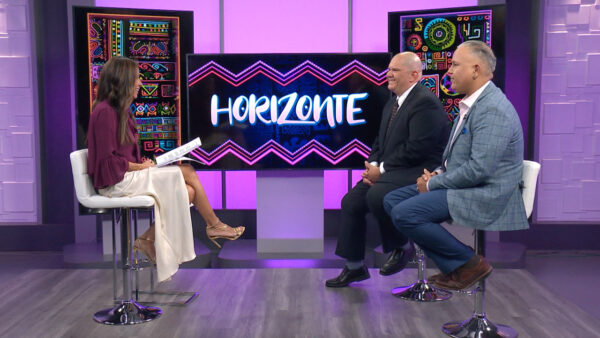ASU Professor Paul Espinosa, with the School of Transborder Studies, talks about an exhibition tracing the contributions and influence of Latino music to American popular music and culture. Espinosa explores how a new generation of Mexican Americans have used music to express their cultural identity and previews “Ballad of an Unsung Hero,” a documentary that chronicles Pedro J. Gonzalez’s life, from his days with Pancho Villa during the Mexican Revolution to his career as a popular recording star.
José Cárdenas: Good evening and welcome to "Horizonte." Tonight, in Sounds of Cultura SOC, the impact of Latinos in American music. We'll take you to an exhibit exploring the contributions of Hispanics to the American musical landscape. Plus, how a new generation of Mexican-Americans expressed their cultural identity through their music. And, a documentary about Pedro J. Gonzalez's life from his early days during of the Mexican revolution to his career as a popular recording star. Coming up next, on "Horizonte."
Announcer: Funding for "Horizonte" is made possible by contributions by the friends of eight, members of your Arizona PBS station.
Ted Simons: Thank you for joining us. I'm José Cárdenas. American music has been influenced by many factors through the years. Something you may not know is that Latino musicians have been one of those factors. In tonight's Sounds of Cultura SOC, a discussion on how Latin rhythms have impacted the sounds of popular music in the U.S. With me tonight is ASU professor and filmmaker Paul Espinosa from the school of transborder studies. Paul, welcome back to "Horizonte."
Paul Espinosa: Nice to be here. Glad to be back.
José Cárdenas: We've talked about your other projects. This one is in connection with a exhibition at the Musical Instrument Museum in North Phoenix. Tell us about the exhibition.
Paul Espinosa: Well, it's American Sabor, a wonderful exhibit on the impact -- the way Latino music has influenced America and vice versa and started in Seattle and done with several people with the University of Washington. Some ethnomusicologists who knew a lot about Latino music and then fortunately, it's traveled here to Phoenix, to the musical instrument museum, which is a wonderful treasure in Phoenix and it's really an opportunity for audiences to see a lot about a lot of different Latino music, focused on five cities -- New York, Miami, San Antonio and San Francisco and you get the feel of the great diversity of Latinos and the great contributions made to American music.
José Cárdenas: Sabor means flavor in Spanish. So it's that Latino flavor in American music. And we'll take a look at a clip of the exhibit right now.
Domingo "Sam" Samudio: UNO, DOS -- ¶¶
Mike Sauceda: "Wooly bully," a classic American hit from the earlier days of rock and roll. But not many people know that Sam the Sham and the pharaohs actually had a sham frontman Domingo "Sam" Samudio was a Mexican-American pretending to be a pseudo-Egyptian. Wooly Bully is just one of many examples how Hispanics have influenced American music. That history is explored in a traveling exhibit at the Musical Instrument Museum in Northeast Phoenix exhibit called American Sabor, Latinos in U.S. popular music. Manuel Jordan Perez is a curator at the museum.
Manuel Jordan Perez: American Sabor really honors all the contributions of Latin music to the music of the United States of America and it's really divided into what are the many centers for that transfusion of musical energy that came from Latin America.
Mike Sauceda: At the exhibit, visitors can learn how American music was influenced by Latinos from five areas. Like San Francisco's Latino contribution, dominated by Santana.
Manuel Jordan Perez: San Francisco really, it's defined by Carlos Santana. He is the one that rules and makes that type of definition, but you know the great thing about Carlos Santana is he included a lot of other musicians. It's something that, back to the original question, Santana, he's Latin but he's universal.
Mike Sauceda: The exhibit has one of the violins that Santana played when his father taught him. Musical influences from Miami and San Antonio are also part of American Sabor. Jordan Perez talks about what visitors will see.
Manuel Jordan Perez There's a lot of materials like posters from the era. You know, showing like big events. Ballroom dancing, big band, you know, presentations. Covers of albums. There's a photo -- you know, from the different time periods and the artists at the peak of their performance abilities but also some of the costumes that they wore.
Mike Sauceda: The exhibit starts with the history and touches on current musical trends.
Manuel Jordan Perez It starts from the 1940s, 1950s, but you dig into the old materials you'll see people coming in here at the beginning of the 20th Century for the first time come from Mexico to the United States. Like L.A., San Francisco. Become immigrants and start becoming part of the musical scene and evolve into something that become known genres. You cannot separate it from the music of the United States in general.
Manuel Jordan Perez: But you will find -- you will find versions of rap that I didn't even know existed. The are particular to certain cities and certain periods.
Mike Sauceda: It has information on how different musical styles from Africa and Europe were fused and adapted and integrated into popular music.
Manuel Jordan Perez: It's this exchange, this mixture that makes us human, American, that is so rich and it's a wonderful place to be able to get a better understanding that and experience of what that means.
Mike Sauceda: Besides seeing and hearing, visitors can participate. There's a dance floor. ¶¶ And you can play producer. Creating your own mix of a song. Jordan Perez says people will walk away moved from American Sabor.
Manuel Jordan Perez: I see people dancing here all ages, ethnic backgrounds. I saw a lady literally on a wheelchair that stood up and started dancing in front of it. If you don't feel this, there's no blood running through your veins. It's just incredible.
José Cárdenas: Paul, it looks like a wonderful exhibit.
Paul Espinosa: It closes on May 18th. If people want to see it, they need to get out there soon to see it. It's a trip down memory lane, the wonderful performance of people that have been around from, let's say, the '40s, '50, '60s, and a lot of interactivity at the music museum. People can play the music and actually work on doing a sound mix and other things, but it's quite a wonderful exhibit.
José Cárdenas: Now, one thing that people won't be able to see because it's over with is the film series that you put together and that's something that is unique to Phoenix. Tell us how that came about.
Paul Espinosa: Basically, the Musical Instrument Museum contacted me about doing a film series in conjunction with the exhibit and asked me to curate something. I was really delighted. I heard about the exhibit before it came to Phoenix. I knew several of the people involved with it at the University of Washington. We basically settled on three different films. It's been here since November, mid-November, and we did a film early in the year and another film in March and then we just did one actually late -- in early may and these were all films to sort of -- you know, connected to Latin music. Two of the films were from the Latin music USA, which was a major series done for PBS, a four-hour series done on PBS originally in the fall of 2009 and two of those shows and one of my own, ballad of an unsung hero, which I think we can talk about later tonight.
José Cárdenas: The first clip we want to talk about is one of the two PBS films, the Chicano wave. We'll show it and then talk about it. ¶¶
Paul Espinosa: In the United States, this is Latin music. ¶¶
Announcer: In the United States, this is Latin music. And this is Latin music. This is latin music, and this is Latin music. Its roots are sometimes obvious. And sometimes not. It has accordions. And it doesn't. It's in Spanish. Except when it's not. The fusion with jazz. Or reggae. New hybrids with country. Or rock. It's as diverse as the Latino experience. As American as it gets. Latin music, USA.
José Cárdenas: So Paul, that clip really drives the point of the diversity of the Latino influence. When you give your lectures that accompany the films, what's the point you emphasize in connection with this particular film?
Paul Espinosa: Well, this film, I chose basically because it looks at the Mexican-American experience, the Chicano wave, looking at musicians in the American southwest. Carlos Santana and Linda Ronstadtand an opportunity to see the great variety and the diversity of what Latinos have contributed to American music, going back to Freddy Fender and some of the other earlier groups but I guess one of the things is also to see how music is kind of like culture and people draw from a lot of sources and musicians in particular are very creative and take different traditions and bring those into their music and you see that. You see the great diversity, how music is a very dynamic place to enact culture, so to speak.
José Cárdenas: And you see the influences on the performers themselves. So for exaple, Ritchie Valens' real name was Ritchie Valensuela. Most of his songs were in English. Not just one, but his biggest hit, LA BAMBA was based Mexican standard.
Paul Espinosa: Yes you see this mixture, you see that it's sort of basically, American culture influenced Latinos and rock and roll being a very important element for Latino musicians in general but there's influence the other way as well. So you're really seeing a kind of meeting in terms of this hybrid nature of the music and I think that's another thing that really, the exhibit tries to bring out, the way Latinos have had an influence on American music and American culture, not just the music itself.
José Cárdenas: And I think some of your audiences would be surprised to know that "Louie Louie" was influenced by Latin background.
Paul Espinosa: Exactly, the whole under-beat, you can see, that's got a real Latin rhythm and you can see that in well known American songs and to its credit, one of the things the exhibit brings out is that impact that's not so obvious to the casual viewer.
José Cárdenas: What kind of reaction have you had from the audiences to whom you've given your lectures?
Paul Espinosa: We've had a tremendous outpouring. We did basically three film screenings and the Chicano Wave and Ballad of the Unsung Hero the last was the Salsa Revolution, about music in New York and in all cases very good turn out, very good discussion, people were interested and learned a lot. The films, I think, are very -- have a big instructional component, good storytelling and I think if -- people found very exciting to come out to a museum and see a film.
José Cárdenas: We don't have a clip of it, but as you mentioned, one of the films is the Salsa Revolution. Tell us about that one.
Paul Espinosa: Well basically that really deals with New York. The scene is New York and it really talks about the FANIA all-stars. Fania was sort of the Chicano label compared to Motown. Most people know smoky Robinson and the miracles and a lot of music that came out of Detroit. FANIA was the counterpart that was created in New York, taking advantage of really principally Puerto Rican, Cuban music. And some of the Willy Colon, Hector Lobo, Reuben Blades and a lot of these musicians came together and became the all-stars which had a long life as a recording group. Some really amazing concerts. Again, this would have been in the '70s and '80s, a big concert at Yankee stadium that had like 50,000 people at it. So we learned some of the story, and the challenges of making a successful label which was very, very challenging for musicians, working with musicians but really, you learn a lot about the -- the salsa scene.
José Cárdenas: And the third film is one of yours. For those of our audience members who don't recall your last appearance on the show, we talked about other films. You're an Emmy award-winning documentarian, and the ballad of the unsung hero. I want to show a clip in just a second, but before we do that, kind of set the stage for us.
Paul Espinosa: This is a profile of a man named Pedro Gonzalez who fought in the Mexican revolution as a young man and came to the United States and worked as a longshoreman and had a lot of musical background and able to start a musical group and start really a recording career and became very, very successful. He was really one of the big successes in Spanish language recordings in the late 1920s and early 1930s and then actually involved in a very controversial court case that sends him to San Quentin Prison for Six Years. And tells a story of a very interesting man. Pedro Gonzalez.
José Cárdenas: Well, let's look at what we have.
Announcer: In the Southwest, the late 1920s witnessed an explosion of Spanish language recording and broadcasting. Los Angeles stations KMBC and KEMW reached hundreds of thousands daily. Other radio announcers soon followed Pedro with their own programs. Despite the competition, no one was as popular as Pedro Gonzalez.
[in Spanish]
Mrs. Gonzales: Young girls would phone asking for Pedro Gonzales, I never told them I was his wife, I'd say no, he just left. But if you leave a message I'll make sure he gets it. They'd say, "I'm waiting for him in the plaza. Tell him not to be long or I'll leave. And I said, "Of course, Miss." Since all the names and dates were different, it was like a jigsaw puzzle. And then I would read the letters, "Oh Pedro, Dedicate a song of love to me. I adore you." And I would make a note on the list for Pedro, "This one loves you, dedicate a song for her."
Pedro Gonzales: She would get so jealous-
Mrs. Gonzales: Why should I get jealous if it was just foolishness on their part?
Announcer: Pedro's radio show was broadcast live from teatro hidalgo, in the heart of the Mexican barrio from 4:00 to 6:00 in the morning. Throughout the southwest, thousands of Mexicans up at the crack of dawn to go to work in the canneries and factories and fields tuned into their radios to hear their favorite announcer and recording styles. ¶¶
José Cárdenas: So, Paul, is -- as the clip indicates, Pedro was one of those perhaps millions of Mexicans who came to the United States during and following the great Mexican revolution, so he had a built-in audience when he arrived here. Tell us how he came here and got started in the business.
Paul Espinosa: Well, like so many of the people involved in the Mexican revolution, the first major revolution of the 20th century, it had a big impact on Mexico and the United States, because so many Mexicans fled the ravages of war and Pedro was among those hundreds of thousands of Mexicans who came.
José Cárdenas: After serving with Pancho Villa.
Paul Espinosa: Exactly, he served as his telegraph operator, so he was extremely knowledgable about what was going on during the revolution. But essentially like many Mexicans, decided economically to come North and came north and as I say, really started working in manual labor. Those were the jobs he could get. In the late '20s, so the economy actually was really booming at the time he comes, so there's a lot of work but he has a lot of background in music and essentially starts singing and is able to get involved with some -- with some people involved in radio. And starts convincing people to let - get some time to do a radio show early in the morning. They give him time in the morning, 4:00 to 6:00, basically thinking the time is worthless. And gets the time on one of the major radio station. Right, he basically is on KMBC, which still is a 500,000-watt station in Los Angeles. And his show was actually broadcast all over the Southwest, even today you can hear that station as far as Oklahoma, New Mexico, Arizona, it's a powerful station and so he had a significant audience, I don't think the station was even aware of. But it was also -- one of the things it alerted the authorities to was that he had -- they started to see he was someone who could turn out a significant audience and some people were actually threatened by that.
José Cárdenas: And that was almost happenstance. He came to the attention of the authorities and based on a fairly innocent message from him.
Paul Espinosa: That's right, one morning, he had heard the people -- the city needs workers in downtown Los Angeles and he asked the listeners, if you need work, come downtown and bring your picks and shovels with you and all of a sudden, hundreds of people were Marching into downtown with picks and shovels looking for work because that's what they heard on the radio and it caught the authorities by surprise and some were very concerned about this. Gee, if he could bring out all of these workers for this, what else could he do? And he got the attention of certain people and as the economy started to sour when the depression hit in the late '20s and the '30s, major repatriation of many Mexicans during this time period, of a much different climate --
José Cárdenas: That included people who were actually U.S. citizens.
Paul Espinosa: Exactly. Maybe a million Mexicans and Mexican Americans repatriated during this time period. A sad chapter, I think, in our country's history. Pedro wasn't repatriated but he did come to the attention of the authorities and they were looking for some way to minimize his influence and essentially one of the things that happened, he was framed in a statutory rape case in 1934. Later, the young woman who was used as a witness, recanted her testimony but it was not allowed to go into the record and he was actually sentenced to San Quentin and served there for six years, but also major defense committees came to his aid. There was a lot of outcry from the community about the injustice that had been done and finally after six years and with the pressure of two Mexican presidents, he was released but deported back to Mexico.
José Cárdenas: And he had the opportunity to enter into a plea deal, right?
Paul Espinosa: They asked him to plead guilty but he refused. He didn't want to stain his name or his family's name and essentially, he could have taken a plea bargain and not served time but he refused and consequently went to prison.
José Cárdenas: And spends most of the rest of his life in Mexico but at a certain point returns to the United States.
Paul Espinosa: He has a successful career in Tijuana, working in radio. His signal did cross the border and later, at a time when many would have retired, in their 70s, he comes back to the United States. He has six American-born children and wants to be more in touch and actually lived to be 101. He was a very -- a person who had a long life and I met him in the -- in the 1980s, and when I met him, he started telling me the story, it was hard it believe all of this was true but as we checked things out, we discovered his stories were very true and, in fact, discovered when this -- this show aired on PBS in the mid '80s, we got letters and they couldn't believe he was still alive. Because this was 50 years after the time he had been in the public eye in Los Angeles and to find out he was alive and actually quite a vigorous man.
José Cárdenas: And you won an Emmy and we know you've got another project in the works. Let's talk about it.
Paul Espinosa: Music is a fascinating subject and I'm working on an documentary. Another San Diego musician, Chunky, he has a group called, the scorpion -- it's a man, a product of the Chicano movement. Very dynamic and he has really wonderful music, Mexican-American, like Los Lobos and their folklore work, and we're really just telling the story of his trajectory as a person committed to his community and causes and a mentor to many, many young people and really somebody who does a lot of work with the schools and the importance of education.
José Cárdenas: When will we see this one?
Paul Espinosa: Hopefully in the next several years. I'm in the process of raising money, which is a challenge for any filmmaker. We've done quite a lot of filming already, but we're trying to get more resources for it.
José Cárdenas: We look forward to seeing it soon. Thanks for joining us on "Horizonte."
Paul Espinosa: Thank you so much.
José Cárdenas: That's it for us tonight for all of us here at "Horizonte," I'm José Cárdenas. Have a good evening.
Announcer: Funding for "Horizonte" is made possible by contributions by the friends of eight. Members of your Arizona PBS station.
Paul Espinosa:Professor, School of Transborder Studies, ASU;




















